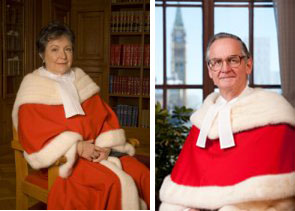
On May 13 Justices Louise Charron and Ian Binnie announced their retirements. This is a little weird, both because it’s very rare that two justices retire at the same time and because Charron is only 60, while the mandatory age of retirement from the Court is 75.
This also means that five of the nine justices of the Supreme Court of Canada will retire during the current Conservative government. And Stephen Harper is going to be the guy who replaces them.
That chill that just ran down your spine is a perfectly normal reaction. But surprisingly? This might all turn out OK. Even for women, gay people, and visible minorities! I know, I was kind of shocked too.
The first opportunity Harper had to influence the Supreme Court was in 2006, when he appointed Marshall Rothstein. Rothstein was questioned by a parliamentary committee with representatives from all parties present — and was the first justice to go through that interview phase, which only started with him — and most of the work behind his appointment was done by the previous Liberal government. During the selection process, Harper said, “this hearing marks an unprecedented step towards the more open and accountable approach to nominations that Canadians deserve.” Rothstein’s nomination was also seen as proof of the non-partisan strength of the Supreme Court. At the time, Patrick Monahan, the dean of Osgoode Law School, said, “Unlike in the United States where the election of a Democrat or Republican president changes who gets appointed, in Canada, the same person still gets appointed. So I think it’s an indication that he’s appointed for his outstanding abilities.”
However, the Prime Minster still gets the final say in who is (or isn’t) appointed (unlike in the US, provinces and parliament don’t get a lot of input). And if you don’t like or trust his agenda, this could be a little worrisome.
According to the Toronto Star,
“How Harper makes his choice will also be important. He promises to follow a more open process, gathering names from Ontario’s attorney general, leading members of the legal community, and the public at large. Five MPs from the major parties will review them and provide a short list of six to the government. Then Harper’s nominees are to answer questions before a parliamentary committee before being appointed.”
However, the process has been changed in the past. While the interview was introduced in 2006, it was skipped in Thomas Cromwel’s 2008 appointment because of an election. There’s also the risk, as the Star points out, that partisan politics could interfere with such a discussion, resulting in a entertaining and hilarious but ultimately probably depressing public “debate.”
The takeaway from all of this is wariness. Obviously Harper can’t go around appointing whoever he wants, because there’s a System to prevent it and because he can be an idiot, but (and I’m saying this very grudgingly) not that much of an idiot. Appointing middle of the road judges is as much in his interests as it is in anyone’s: while they may not explicitly agree with, for example, supporting a left-wing social agenda, they also aren’t supporting a crazed paternalistic patriarchy (at least, not so far). According to an editorial in the National Post,
“Mr. Harper has an unprecedented opportunity to shape a thoughtful, prudent and experienced court, one which respects both the rights of litigants and the limits of judicial power. We hope that the Prime Minister chooses his appointees wisely, and that he does so through a transparent process that allows both MPs and the Canadian public to understand the legal philosophy of the men and women who sit on our top court.”
In other words, regardless of your personal opinion on Harper, ranging from “a person who exists” to “possible Skynet cyborg,” the fact that he will ultimately be responsible for so many Supreme Court appointments is… not completely terrifying. At least not yet.







